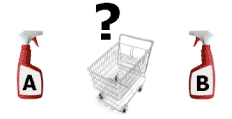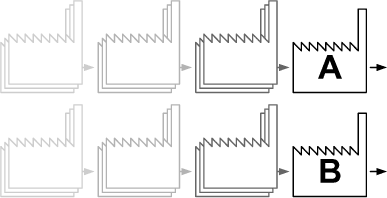|
| Front page | | Contents | | Previous | | Next |
Development of cleaner products in Berendsen's international product chains
Summary and Conclusions
1.1 Background and purpose
When standing in the supermarket choosing between two or more products that can fulfil the same function, there is a number of factors which influence your choice. This is also the case when a company is about to select a supplier. Here the following parameters typically apply:
- Price
- Quality
- Supply security
- Service and support
- Environmental conditions
- And others

Figure 1. There are many considerations when choosing between product A and product B.
All the above parameters are a result of the interaction in the whole product chain – from cradle to grave. Your choice in the supermarket can thus be seen as a competition between two product chains more than between two companies.

Figure 2. When two companies (A and B) compete on the market – it is in fact a competition between two product chains.
Optimizing the product chains of the company in the whole life cycle can thus give a better competitiveness.

Figure 3. Cooperation in the value chain to improve the competitive parameters for the final product/service results in better competitiveness. This is one of the motivational factors for the players in the value chain to cooperate on optimization of the value chain from cradle to grave.
In the project, focus has been on this product optimization in the case of Berendsen Textil Service’s supply of soaps and creams, which are delivered as a supplement to the textile service.
The purpose of the project has not only been to carry out concrete developments. It has equally been to communicate the experience to other interested companies and to inspire them to start development of cleaner products themselves – in Denmark as well as internationally.
Environment is not the most significant sales parameter for Berendsen Textil Service A/S, but still one of major significance. At the same time, the environment is one of the points where Berendsen has an opportunity to differ from its competitors – and when all things are equal then the environment might be the decisive factor in a sale.
1.2 The study
FORCE Technology and Berendsen Textil Service A/S, in cooperation with Berendsen’s suppliers, have completed a number of development procedures to introduce more environmentally friendly and healthy products on the market. Focus has been on Berendsen’s hygiene products which, among other things, include soap, hand cleaner, lotion, sanitizer liquid and similar cosmetic and chemical products. The products are delivered as a supplement to Berendsen’s textile service concepts with laundry and rental of textiles.
The barriers encountered during the project are described and the information on how the barriers were overcome will be especially interesting for other companies wishing to offer cleaner products to their market.
The project has been embedded in Berendsen’s sales and marketing division and the results have been integrated in the sales organization so Berendsen can actively make use of the competitive advantages connected to the newly developed products.
1.3 Main conclusions
The project shows that it is possible to develop cleaner products for the market in cooperation with one’s suppliers and to achieve positive response from the market.
It has turned out that it is possible to overcome most of the substantial barriers to development by being persistent and patient. A consequence of this is that it should be borne in mind that development projects take a long time.
Examples of barriers overcome in the process are:
- Different preferences on the market for Berendsen and the suppliers
- Long communication channels
- Differences in terminology and language
- Physical distance
- Lack of knowledge
- Contractual barriers
- Weak “power” relations to the supplier
The experience from Berendsen shows that as a starting point it is easier to cooperate with a supplier in Denmark about development than a supplier from abroad and outside Europe, and it is often necessary to provide the supplier with a large amount of knowledge and competences in relation to, for instance, relevant legislation in the EU to achieve success.
It is no wonder that this is the reality in light of the fact that the biggest barrier is in companies’ understanding of the demands of the market. A company in Denmark knows the Danish customers’ preferences, while a business partner in southern Europe wants his products to meet the demands of his own market. In southern Europe “clean” often means that it smells good (of perfume). This is in direct conflict with the demand for a perfume-free product which often can be found in the Nordic countries.
At a related after-work workshop the participants from a number of Danish companies concluded that the customers’ demands for environmentally friendly products can be handled positively as an input to innovation. Minutes of the after-work workshop are enclosed as Appendix C.
1.4 Project results
1.4.1 New clean products on the shelves
During the project Berendsen developed and introduced 11 new products with a smaller impact on the environment and health. However, some of the products were not developed as a part of the project, but in parallel with the development project. However, the total experience is communicated to get a broad coverage of the challenges which can be encountered in the cooperation with the suppliers.
1.4.2 Barriers are overcome
Based on the experience from Berendsen, the recipe for success is, as mentioned earlier, patience and persistence in relation to suppliers. However, there are some cases where barriers cannot be overcome on their own and here it might be necessary to find another supplier/business partner. In one case Berendsen got help from the legislation, which put pressure on the supplier so that he had to change his product anyway.
1.4.3 Legislation and tools help you on the way
Exactly legislation can be a partner in development projects. Legal requirements on transparency in relation to constituents in cosmetic products give a far better starting point than in the case of chemical products where the producers are often very secretive about information. Harmonized EU legislation makes it easier to cooperate with international suppliers about development of products. In future, the new EU requirements in relation to specification of allergy-causing perfume substances will help Berendsen who, for a long period, have been working on getting their suppliers to phase out these 26 substances in products with perfume where there is a risk of getting into contact with the product.
Ecolabelling criteria can also give inspiration on how new products can be combined so impact on the environment and health is reduced. At the same time the chemical list from the ecolabelling scheme gives much valuable information about individual substances. However, experience from Berendsen’s products shows that the ecolabelling criteria sometimes give too little consideration to life cycle thinking. For instance it can be proved that Berendsen’s new foam soap without perfume and colour burdens the environment far less than an average ecolabelled cream soap for each hand wash. Nevertheless Berendsen’s foam soap cannot be assigned the ecolabel because the criteria do not relate the environmental impact to the functional unit, i.e. in relation to the number of times you can wash your hands with the soap.
Berendsen’s Code of Conduct shows suppliers from the beginning of a relationship that being a supplier to Berendsen involves some obligations – also within the environment. With this tool Berendsen ensures that suppliers will not be shocked when Berendsen starts to clarify environmental improvements of products.
Berendsen has many suppliers – and it is not possible to keep a close dialogue with all. Therefore, Berendsen’s suppliers are regularly evaluated with the internet-based supplier evaluation tool – Supplier-e-valuation® - from FORCE Technology.
1.4.4 The sales staff are equipped
Berendsen has created an intranet portal for sales representatives where they can always find relevant and updated documentation in the form of product sheets, user’s manual from the suppliers, perfume declarations and similar. At the same time the intranet portal gives brief background information for each product and concrete sales arguments including environmental and health aspects.
In this way Berendsen expects that the efforts to develop cleaner products can result in an even greater plus on the bottom line
1.4.5 The development does not stop here
For Berendsen, development of a new cleaner product and introduction on the market does not mean that the work is done. They are always looking for further improvements of the products in relation to market trends and in relation to new technical knowledge.
This means that even if this project ends, Berendsen’s customers can also expect new products with improved environmental and health profiles in the future.
| Front page | | Contents | | Previous | | Next | | Top |
Version 1.0 March 2006, © Danish Environmental Protection Agency
|